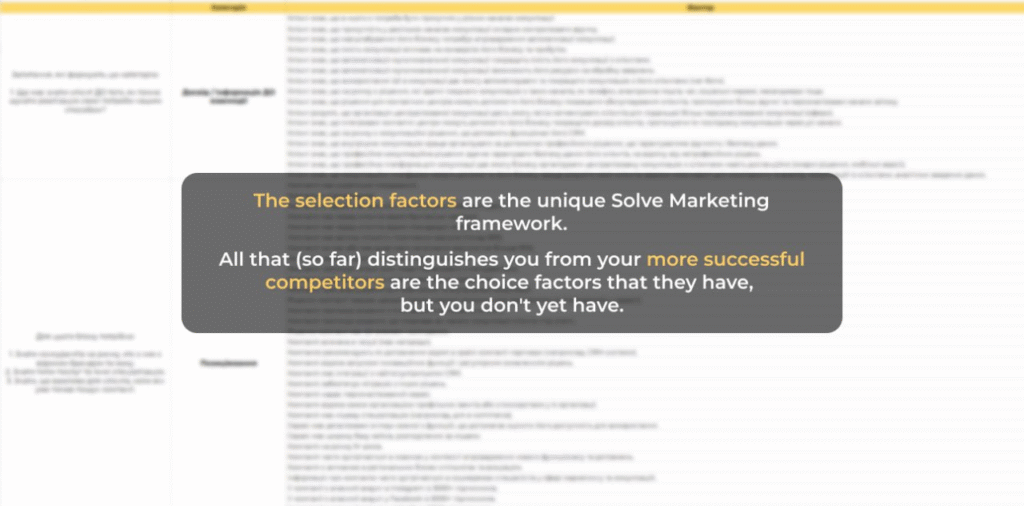Every new market always involves risk. And when it comes to the food business, which depends on tastes and cultural habits, the risk doubles.
Natalia, founder of a culinary school, has come a long way: from a pastry school in Ukraine to launching master classes in Bulgaria. A new country means new rules of the game.
In Bulgaria, she faced completely different challenges:
- uncertainty about who will form the core audience — Ukrainians or local residents;
- language barrier in communicating with Bulgarian audiences;
- vague ideas about competitors and their strengths;
- and the main question is whether there is any demand for culinary training in Sofia, and in which niche it is worth starting.
Natalia came to Solve Marketing with the following request:
Figure out whether it is worth scaling the idea, how to find your place in the market, and what steps to take to achieve operational profitability.
This is where our story begins.
Project: cooking school in Bulgaria
A project that combines gastronomy and emotional experience.
Its founder, Natalia, had been conducting culinary master classes in Ukraine for over 8 years, creating an atmosphere of trust and ease, where children and adults learned to cook, experimented with flavors, and discovered cooking as a form of creativity.
After moving to Bulgaria, she decided to launch a new venture — master classes in confectionery for children and adults. This is not about professional culinary education, but about leisure activities that bring families, friends, and colleagues together, create warm memories, and provide new experiences.
The development plans include several promising formats:
The 150 m² space in the center of Sofia allows for flexible transformation of the space — from a cozy classroom for children to a hall for corporate events or gastronomic evenings.
Project objectives
The key objective is to assess the prospects for launch and find a strategy for entering the Bulgarian market.
But before the launch, there were several questions that would determine its success:
- Who will be the primary target audience — Ukrainians in Bulgaria or local residents?
- How to overcome the language barrier and build communication with a new audience.
- Which niche to start in order to compete with well-known culinary schools.
- Which additional formats will provide a faster path to profitability?
Market analysis
Market analysis is the foundation of any strategy, as it protects against ineffective investments and helps to understand audience behavior. It allows you to assess the potential of a niche and choose the right promotion format.
NSI research data show:
- Young people aged 15–29 spend 2 hours and 20 minutes a day on food, which hints at their openness to gastronomic formats.
- Bulgarians spend most of their free time watching TV and videos (2 hours and 6 minutes) and on social media (52 minutes).
- Only 15–20% of time is spent on hobbies and activities outside the home.
- Children have different priorities: sports, games, and videos, but culinary activities can be organically integrated into family or educational leisure activities.
Stimulating factors for market development
- Desire to learn new skills.
- Holiday formats (Christmas, Easter, Valentine’s Day).
- Interest in the cuisines of other countries.
- Growth in gastronomic tourism (3–5% of all European tourists).
Restraining factors
- Limited understanding of culinary master classes as a form of recreation.
- High price (a barrier for many participants).
- Lack of time in the classroom.
- Discomfort preparing in front of strangers.
The market for culinary master classes in Bulgaria is niche but promising. Demand is primarily driven by food enthusiasts who value healthy eating, specialized cuisines (Japanese, Thai, Italian, French), and dietary formats such as vegan and gluten-free.
An important driver of trust and engagement is collaboration with renowned chefs, who emphasize the brand’s expertise.
In terms of seasonality, peaks in interest occur in December (Christmas), April–May, and August–October, which requires synchronization of communication campaigns with the holiday calendar and seasonal events. The market is not oversaturated, but it requires targeted positioning rather than mass advertising.
💡 Insight: premature entry into the market with advertising without understanding seasonality and demand factors is doomed to drain the budget. That is why we always start with in-depth market diagnostics: we identify real audience behavior patterns, seasonal demand points, and determine the channels through which the customer actually makes decisions. This saves money and allows us to immediately build targeted communication.
The market is not static: trends, the competitive environment, and audience behavior are constantly changing. Therefore, analytics is not a one-time action “at the start.”
- At least once a year — to update the vision and adjust the strategy.
- Before each scaling — entering a new country, launching a new product or segment.
- During periods of turbulence (crisis, changes in purchasing power, new regulations) — definitely.
Want to understand whether your product has prospects in a new market and where to start launching it? Sign up for a free consultation with a Solve Marketing marketer — we will break down your market for you.
💡 Insight: most companies lose money not at the advertising stage, but at the stage of lack of analytics. We often see businesses launching campaigns “blindly,” relying on their own ideas instead of real data. Our approach is to always start with facts: we don’t sell tools, we sell sound decisions. And that’s what allows our clients to scale without chaos.
Competitor analysis
A strategic tool that allows you to see where the market is already saturated and where there are windows of opportunity.
Competitive analysis is necessary in order to dispel market illusions. Businesses often think that “there are few customers because the price is high” or “everyone wants holiday formats.” In reality, the reasons are completely different: the wrong promotion channel, lack of trust, poor website structure, or weak content management.
We always look at competitors from two sides:
- Content — what messages, formats, and communication channels they use.
- Operational — how sales processes are structured, what factors influence customer choice, how reputation is managed.
This allows you not only to “know your competitors,” but also to see how to get around them: whether through a different format, stronger trust-building, or systematic marketing.
💡 Insight: businesses often limit themselves to superficial analysis of competitors, which is done by internal employees “between other tasks.” But it is independent strategic auditing that opens up unexpected opportunities. This is no longer a tactical response to the actions of others, but a strategic vision that brings the brand into its own niche.
It is also important to conduct competitive analysis not only at the start, but regularly. Because the market is alive, and those who seemed unattainable today may lose their positions tomorrow.
The market for culinary master classes in Sofia appears to be well-established but not overly saturated. We conducted a detailed analysis of three key competitors and identified several important patterns:
- There is demand, although it is concentrated in several niches — holiday and family formats, cooking as a gift, and corporate events.
- The market price ranges from 45 to 110 leva. The price in the higher segment must be justified by additional value — a unique format, brand, or partnership.
- Competitors’ communication is uneven: Facebook remains the key channel, but few work systematically with Instagram, email marketing, or advertising.
- Reputation marketing (collecting and working with reviews) is one of the critical factors in the selection process. Food Connection actively uses it, while other competitors pay less attention to it.
Competitor analysis is about understanding the playing field in which you will have to operate. We look not only at prices and product range, but also at:
- brand positioning and messaging;
- promotion channels and their effectiveness;
- mechanics of attracting and retaining customers;
- the strengths and weaknesses of the service as seen by customers (through reviews and case studies);
- reputation and partnerships.
This approach allows you not only to create a “comparison table,” but also to see systemic gaps in the market that can be used to create a unique customer offering.
Want to get detailed analytics on your competitors and understand where your growth opportunities lie? Sign up for a free consultation with Solve Marketing — and we’ll show you your competitors in the mirror of their real strengths and weaknesses.
Website analysis and recommendations
At the time of our research, the project was still in the business idea stage and did not yet have its own website. This is an opportunity to start your digital presence right away, without repeating the mistakes of others.
In culinary master classes, customers buy not just training, but experience and atmosphere. And the first window into this experience is the website. This is where people first get acquainted with the brand, evaluate its aesthetics, trustworthiness, structure, and ease of communication.
We always view a website as an investment in sales and trust. Therefore, we suggest developing it in stages, depending on the scale of the business and its willingness to invest in a digital presence:
Analysis of competitors’ websites
During our work, we carefully studied the websites of local players. And the main conclusion is that most websites do not meet modern UI/UX standards. They are either outdated, poorly structured, or do not work for sales. This provides enormous scope for immediately building a digital presence that is several steps ahead of the market:
- stand out through aesthetics and visuals that emphasize the brand’s atmosphere;
- create a website logic that leads the user to an application or purchase, rather than simply informing them;
- Integrate analytics and SEO from day one so that every click works to grow your business.
💡 Insight: most companies create a website just for the sake of it, and then spend years trying to improve it. We recommend starting with your business goals: a website should be a sales tool, not just an online business card. That’s why it’s important to set up the right architecture and think through the customer journey right from the start.
Social media analysis
Social media is not a “display case with photos of desserts.” In our model, it plays three roles simultaneously:
- build trust (personal brand + social proof);
- generate demand (seasonal occasions + participation triggers);
- collect leads (booking mechanics + automation in DM).
We analyzed the profile and provided expert recommendations on the following areas:
- Branding and recognition: how to update and improve your avatar, profile header, Highlight, and formats.
- Content and narrative: how to maintain balance in content and what formats to use to address customer “pain” points.
- Posting tactics: we have outlined tactics for Reels, Stories, Posts, and not only for Instagram, but also for other social networks.
- Engagement and lead generation mechanics.
- Quick hooks for Reels.
We have outlined each block in detail so that we can immediately implement changes that will increase recognition, trust, and engagement.
Additionally, we analyzed our competitors’ social media accounts.
On the market, however, we see a different picture: competitors are chaotic, their accounts lack structure, and booking mechanics are often confusing. This opens up opportunities to win with structure, personal narrative, and clear funnels.
That is why we developed a 90-day content strategy based on six pillars: emotions, expertise, founder stories, UGC and reviews, seasonal formats, and product offers.
We have also established systematic reputation marketing, which helps build trust.
Lead generation analysis
Diagnosis of marketing dynamics in the niche: who is actually investing in promotion, on which platforms, with what messages, and which mechanisms are bringing results.
In the case of culinary master classes in Bulgaria, we see low competition in the advertising field:
In Google Ads, advertising campaigns are not found in the top positions, which are dominated by “emotion” aggregators and coupon services. This indicates that companies do not compete on bids and do not occupy premium positions in search results.
Meta (Facebook and Instagram) has almost no direct advertising for cooking master classes. Competitors do not use the platform systematically, limiting themselves to occasional campaigns.
The uniqueness of lead generation strategies
It is important to understand that lead generation in such a niche cannot be uniform. For projects where demand has not yet been established, non-standard funnel models work:
- Content lead generation: launching Reels, articles, recipes as “hooks” for traffic.
- Partnership: cooperation with local travel agencies and “emotion” services.
- Event marketing: creating limited offers for holidays (Christmas, Easter) that are easy to promote through targeted advertising.
Lead generation analysis is necessary to clearly understand where there is room for growth and which channels can be occupied at minimal cost. It shows which type of funnel to launch first — direct communication or demand generation — and allows you to avoid typical mistakes made by competitors.
Comprehensive approach
At Solve Marketing, we don’t view lead generation as “just running ads.” It’s a complex process:
- content → advertising → SEO → partnerships → reputation marketing, which are built as a single system.
That is why our analysis is always carried out by a team of specialists: a content marketer researches messages and formats, operational marketer evaluates the structure of the funnel and processes, targeting specialist analyzes Meta Ads (segments, creatives, bids), and PPC specialist tracks search advertising, competition, and bid effectiveness. As a result, the client receives a complete map of the market with clear entry points for their own advertising strategy.
Want to get a lead generation map specifically for your project with concrete steps, budgets, and forecasts? Sign up for a free consultation with a Solve Marketing specialist — we’ll show you how to quickly test the market and attract your first customers.
Factors of choice
When a customer chooses a culinary master class, they never do so based on complete information. In most cases, the decision is based on emotions, recommendations, or several “signals” that are perceived as sufficient for trust. That is why the task of the business is not only to create a product, but also to systematically manage the choice factors that influence every step of the customer journey.
Insight: in an environment where demand has not yet been established, customers often do not understand why your product is worth their attention. They only see part of the puzzle: a beautiful picture on Instagram, a competitor’s website, or a recommendation from a friend. If these signals are weak or inconsistent, the choice will not be in your favor.

We have compiled a proven list of 140+ choice factors, each of which is ready for implementation. This allows you to positively influence the customer at all stages of interaction with the business — from the first contact to the aftertaste of the experience.
Analysis of choice factors allows you to:
- see where customers are already getting information about the brand today and what signals are key;
- determine which factors are critically important in the culinary master class niche;
- understand which weak signals need to be strengthened in order to increase the likelihood of choosing this particular brand.
Businesses often focus on only one or two factors (such as price or photos on social media), forgetting that customers always see a mosaic of signals. Customers choose those who work systematically and comprehensively: from the first contact to the end of the interaction. It is this multi-level approach that becomes a real competitive advantage.
Want to find out what factors influence choice in your niche and how to strengthen them? Sign up for a free consultation with a Solve Marketing specialist — we will help you build a system that will convince customers to choose you.
Basic marketing strategy
What happens after the analysis stage
Analytics is the starting point. Next, we move on to strategy development and launch a cycle of hypotheses → tests → scaling.
1) Formulate hypotheses: audience, pricing and barriers, promotion channels.
2) We design basic strategies:
- SMM strategy: content plans, cadence, Reels scripts, Highlights as trust, UGC loop, DM scripts, and link hub for booking.
- Lead generation: multi-channel funnel (IG/FB Ads → DM/form → booking), quick wins through events/holidays, partner collaborations, retargeting, promo codes.
- Digital foundation: landing page/microsite with clear CTA, local SEO, GA4 + Pixel + UTM tracking, reputation scenarios for collecting reviews.
- Partnerships: restaurants/cafes, event agencies, educational centers, influencers — package deals and joint activations.
Why do you need a marketing strategy?
- To obtain detailed, high-quality diagnostics of the market and competitive field;
- See holistic marketing architecture: content → advertising → SEO → partnerships → reputation, stitched together into a single system with analytics (GA4, Pixel, UTM) and transparent KPIs.
- Now you are working not with “inspiration,” but with a market map and a plan of priority hypotheses: audience, offers, creatives, channels, budget constraints.
- You will also learn basic strategies for SMM, lead generation, content, SEO/websites, and partnerships.
- As a result, this will lead to complete synchronization within the team in terms of priority use of tools and the path to achieving business goals.
Ready to reduce risks and move towards predictable growth?
Sign up for a free consultation with Solve Marketing. You will receive a market map, priority hypotheses, budget constraints, and KPIs.





